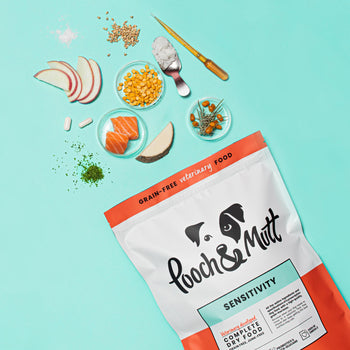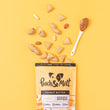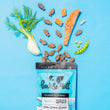
FREE UK DELIVERY ON ORDERS OVER £39.99
If your pooch has a sensitive stomach, suspected food allergies, or suffers from chronic digestive issues, your vet may have suggested hydrolysed dog food. But what is ‘hydrolysis’, and why is this food such a hero for turbulent canine tummies?
In this article, we’ll lay out the facts about hydrolysed dog food and delve into its uses for food allergies and stomach sensitivity in dogs. Read on to learn whether hydrolysed food might be useful for your pooch.
Hydrolysed dog food is a specialist diet for dogs that have trouble digesting certain foods.
This could be because of
It’s also useful for dogs who have skin complaints caused by an allergy.
Hydrolysed food looks like regular dry dog food or kibble, but inside each piece, the proteins have been broken down into their base amino acids, so they pass through a dog’s body without triggering an immune response.

We asked Pooch & Mutt’s resident Vet Linda, about her take on hydrolysed dog food, and she states:
“I'm a huge fan of hydrolysed diets, where appropriate. It is great to be able to offer owners a "safe" source of food when more mainstream diets just aren't appropriate. For those dogs with allergies, it is important to understand that diet isn't always the magic bullet we want it to be.
This is because many dogs also have environmental allergies causing reactions, and they're also commonly dealing with secondary bacterial and yeast infections, which need to be addressed. But still, a hydrolysed diet is an important part of the treatment plan for many of my patients.”
Hydrolysed dog food is made through a method called hydrolysis. As specific protein molecules are usually responsible for triggering allergic reactions in dogs, hydrolysis pre-splits those molecules with a gentle, water-based process.
If you imagine the chain of amino acids which make up a protein, it is separated, through hydrolysis, into its individual links.
When a dog eats the hydrolysed food, their immune system doesn’t recognise the broken-down molecules as a threat, and therefore doesn’t respond in the usual, protective way. In other words, hydrolysis allows the proteins to basically wear a disguise. In theory, this means a dog that is allergic to chicken could eat hydrolysed chicken with the reduced risk of a reaction.
Hydrolysed food is a great option for dogs with digestive issues, intolerances, allergies, or those who have trouble eating regular food. Here are the benefits and drawbacks of hydrolysed food.
Pros

Cons
A vet will prescribe this sort of food if your dog has shown symptoms of gut sensitivity or allergies. Here are some signs to watch out for:
Sensitive stomach or intolerance
Food allergies
You should only feed your dog hydrolysed food if they have suspected food allergies, intolerances or a chronic digestive issue (and if your vet has recommended it). It isn’t a viable option for dogs who can eat regular food.
It’s important to note that only vets can prescribe hydrolysed food and give you specific advice around an eating schedule. If you think it’s something your dog would benefit from, get in touch with your vet to discuss potential options.
Some dogs are prescribed hydrolysed food for the rest of their lives, due to their advanced age, allergies or because they have a chronic illness. Some dogs, however, are advised to eat hydrolysed food for a short period, such as 3-8 weeks, which gives their body time to heal and inflammation to reduce until they’re ready to try their regular food again.
Always ask your vet for specific advice regarding your pooch.
The best hydrolysed dog food will have a few indicators that it’s better than the rest.
For the perfect blend of a potentially novel protein and hydrolysis, our Pooch & Mutt dry dog food for allergies is vet developed and uses hydrolysed salmon, which may be a novel protein for your dog, along with coconut oil, fibre-rich apple pulp and a burst of probiotics and prebiotics to keep your pooch’s sensitive gut running smoothly.
Disclaimer: Whilst our dry food for dogs with food allergies or intolerances does contain hydrolysed proteins, it also includes salmon protein. We use salmon to keep it mono-protein, and because it's a protein that is the most hypoallergenic. Any questions, be sure to contact our expert team.

Our entire vet-developed range was specifically designed to help out those pooches who need a bit of extra helping paw when it comes to their health and nutrition, and need their food on prescription. Shopping our vet range, whether that’s for diets that target Sensitivity, Gastrointestinal, Renal or Hepatic conditions, gives you peace of mind that your special pooch is getting everything they need to support their condition and get the nutrition they need.
If you need to simplify your dog’s diet due to stomach sensitivity or want to try an elimination diet, you could try some alternatives to hydrolysed dog food.
It can take between 3 to 8 weeks to see the effects of hydrolysed food as your dog’s body clears itself of potential allergens. Also, it depends on the reason you’re using it. If you’re trying an elimination diet to identify an allergy, stick it out for 6-8 weeks without giving treats or any sneaky extra foods. If you’re looking to see a skin allergy clear up, this can take at least 4 weeks, while sickness or diarrhoea might start improving in just a week. In any case, if you don’t see any improvement within 12 weeks, get in touch with your vet for advice.
The main difference is that hydrolysed dog food has been through a gentle, water-based process that breaks down the amino acids of protein into small, singular molecules. These small pieces of protein go ‘undetected’ in the body, so they’re easily digested by dogs with sensitive stomachs, digestive disorders and/or food allergies, without triggering an immune/allergic response. Hydrolysed food is the perfect option for dogs who need to eat without risking sickness, for instance, following an allergic reaction, or during an elimination diet. Pooches with chronic digestive disorders (such as IBD) can eat it for much longer, but in all cases, hydrolysed dog food should always be recommended by a vet.
If your dog has a sensitive stomach or food allergies, the best dog food is stripped down to basic, gently digestible ingredients. This can include a single protein diet (just fish, plain potato and a vegetable, for instance), and/or the use of a novel protein (a protein your dog hasn’t eaten before, potentially rabbit, venison, salmon or duck).
If your pooch has food allergies or chronic digestive issues such as IBD, speak to your vet about whether they’d benefit from going on a hydrolysed dog food diet. This is a specialist dog food that can move through a dog’s digestive system without triggering a reaction.
If your pooch has pesky digestive issues or a potential food allergy, try our range of food for dogs with sensitive stomachs. From single protein recipes to digestible fish, potato and peas, they’re perfect for healing your dog’s sensitive tummy. Remember to always consult your vet before switching to a specialist hydrolysed dog food.
Never miss a treat!
Subscribe to our newsletter and get blog articles amongst other treats delivered to your inbox






Comments (0)
Leave a comment